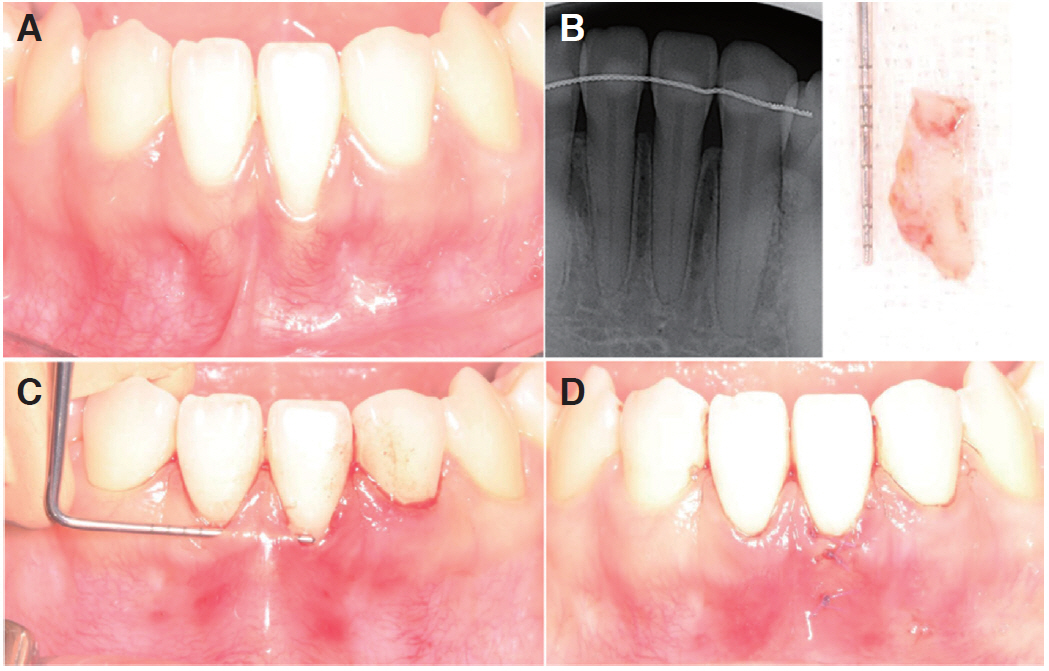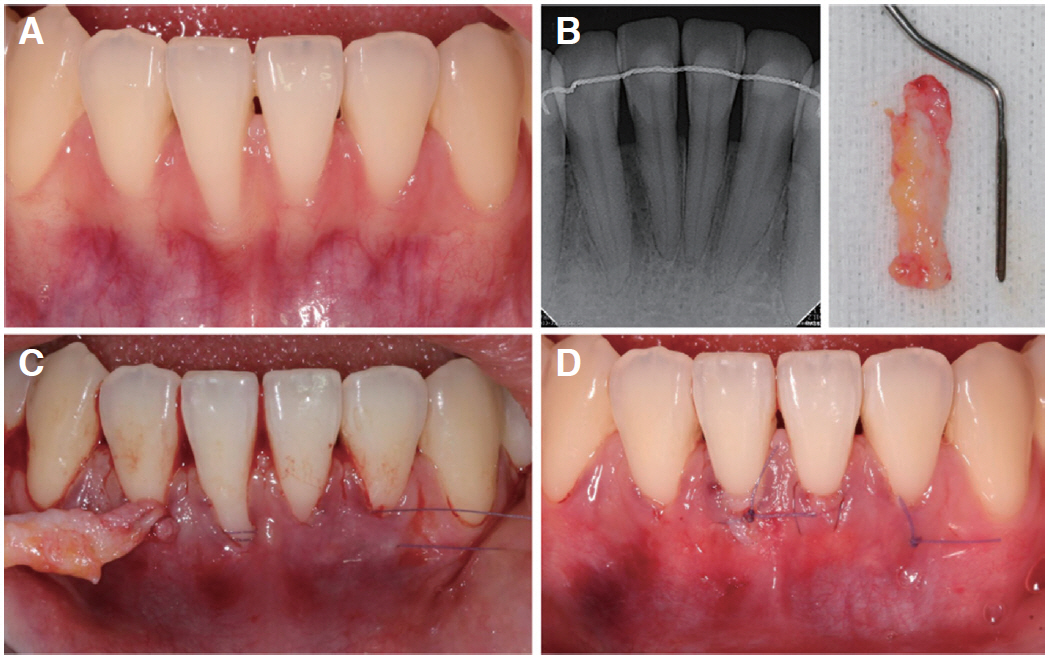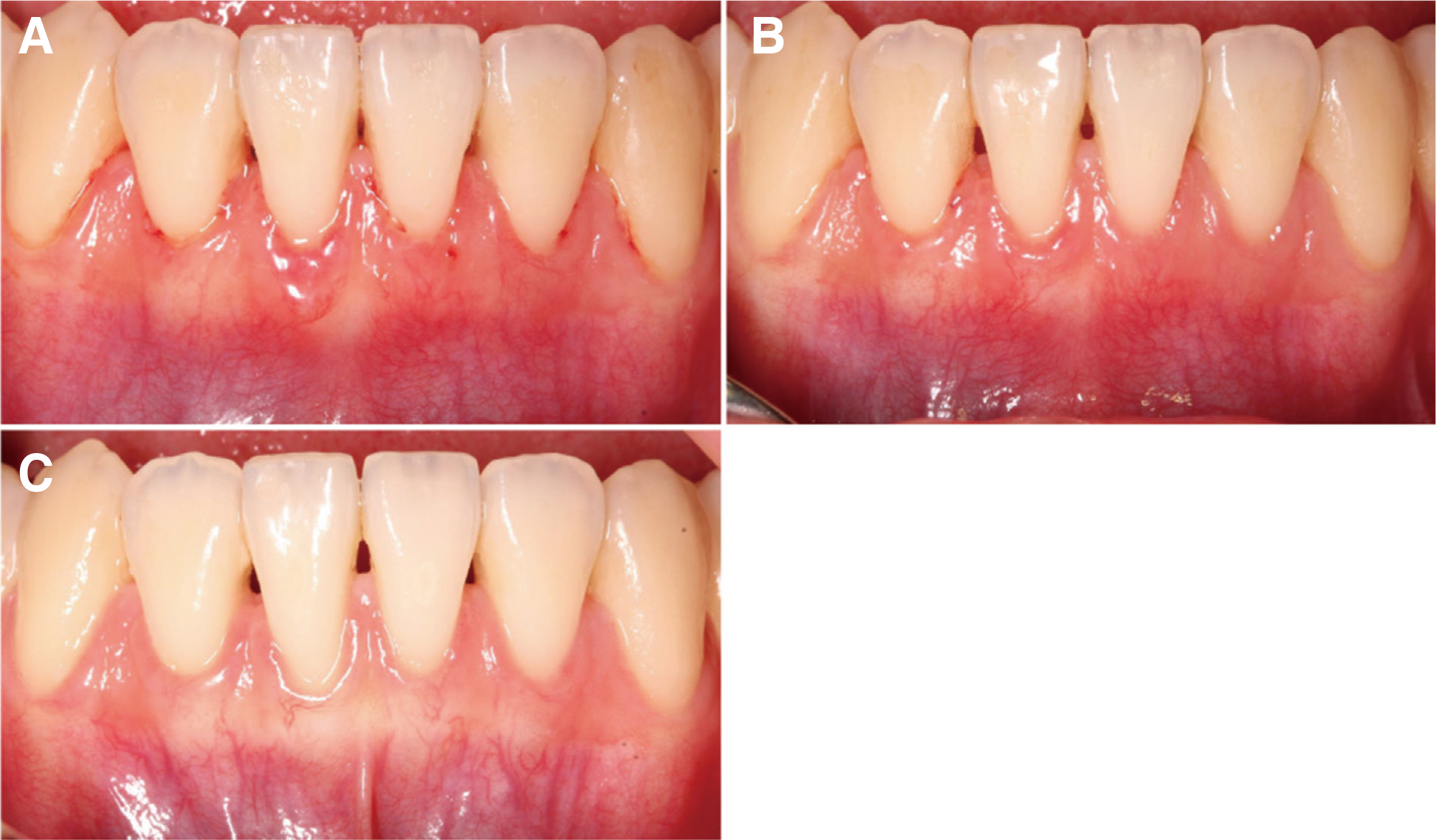J Dent Rehabil Appl Sci.
2019 Dec;35(4):253-259. 10.14368/jdras.2019.35.4.253.
The laterally closed tunnel for the treatment of mandibular gingival recession in thin biotype patients: case report
- Affiliations
-
- 1Department of Periodontology, Dental and Life Science Institute, School of Dentistry, Pusan National University, Yangsan, Republic of Korea. joojy@pusan.ac.kr
- 2Department of Periodontology and Dental Research Institute, Pusan National University Dental Hospital, Yangsan, Republic of Korea.
- 3Dental Clinic Center, Pusan National University Hospital, Busan, Republic of Korea.
- KMID: 2470631
- DOI: http://doi.org/10.14368/jdras.2019.35.4.253
Abstract
- In this case report, gingival recession of the mandibular anterior teeth was treated with a laterally closed tunnel technique. Two patients had altered the inclination of mandibular anterior tooth during past orthodontic treatment and had periodontal thin biotype. The recipient site was formed by tunneling method, and the connective tissue graft obtained from the palatal side was placed in the tunnel, and the margins of flap were gathered at the center of the root and sutured. Despite the thin periodontal biotype, the root coverage was successfully obtained, keratinized gingiva was increased, and aesthetics were achieved by harmonizing with surrounding tissues in terms of shape and color.
MeSH Terms
Figure
Reference
-
References
1. Armitage GC. 1999; Development of a classification system for periodontal diseases and conditions. Ann Periodontol. 4:1–6. DOI: 10.1902/annals.1999.4.1.1. PMID: 10863370.2. Kassab MM, Cohen RE. 2003; The etiology and prevalence of gingival recession. J Am Dent Assoc. 134:220–5. DOI: 10.14219/jada.archive.2003.0137. PMID: 12636127.3. Wennstrom JL. 1996; Mucogingival considerations in orthodontic treatment. Semin Orthod. 2:46–54. DOI: 10.1016/S1073-8746(96)80039-9. PMID: 9161283.4. Merijohn GK. 2016; Management and prevention of gingival recession. Periodontol 2000. 71:228–42. DOI: 10.1111/prd.12115. PMID: 27045439.5. Ruf S, Hansen K, Pancherz H. 1998; Does orthodontic proclination of lower incisors in children and adolescents cause gingival recession? Am J Orthod Dentofacial Orthop. 114:100–6. DOI: 10.1016/S0889-5406(98)70244-6. PMID: 9674687.6. Renkema AM, Fudalej PS, Renkema A, Bronkhorst E, Katsaros C. 2013; Gingival recessions and the change of inclination of mandibular incisors during orthodontic treatment. Eur J Orthod. 35:249–55. DOI: 10.1093/ejo/cjs045. PMID: 22828081.7. Frost NA, Mealey BL, Jones AA, Huynh-Ba G. 2015; Periodontal Biotype: Gingival thickness as it relates to probe visibility and buccal plate thickness. J Periodontol. 86:1141–9. DOI: 10.1902/jop.2015.140394. PMID: 26110452.8. Yared KF, Zenobio EG, Pacheco W. 2006; Periodontal status of mandibular central incisors after orthodontic proclination in adults. Am J Orthod Dentofacial Orthop. 130:6–8. e1. DOI: 10.1016/j.ajodo.2006.01.015. PMID: 16849063.9. Melsen B, Allais D. 2005; Factors of importance for the development of dehiscences during labial movement of mandibular incisors: a retrospective study of adult orthodontic patients. Am J Orthod Dentofacial Orthop. 127:552–61. DOI: 10.1016/j.ajodo.2003.12.026. PMID: 15877035.10. Chambrone L, Tatakis DN. 2015; Periodontal soft tissue root coverage procedures: a systematic review from the AAP Regeneration Workshop. J Periodontol. 86:S8–51. DOI: 10.1902/jop.2015.130674. PMID: 25644302.11. Sculean A, Allen EP. 2018; The laterally closed tunnel for the treatment of deep isolated mandibular recessions: surgical technique and a report of 24 cases. Int J Periodontics Restorative Dent. 38:479–87. DOI: 10.11607/prd.3680. PMID: 29889911.12. Zucchelli G, Mele M, Stefanini M, Mazzotti C, Mounssif I, Marzadori M, Montebugnoli L. 2010; Predetermination of root coverage. J Periodontol. 81:1019–26. DOI: 10.1902/jop.2010.090701. PMID: 20192618.13. Leong DJ, Wang HL. 2011; A decision tree for soft tissue grafting. Int J Periodontics Restorative Dent. 31:307–13. PMID: 21556387.14. Hwang D, Wang HL. 2006; Flap thickness as a predictor of root coverage: a systematic review. J Periodontol. 77:1625–34. DOI: 10.1902/jop.2006.060107. PMID: 17032103.15. Garces-McIntyre T, Carbonell JM, Vallcorba L, Santos A, Valles C, Nart J. 2017; Coronal advanced flap in combination with a connective tissue graft. Is the thickness of the flap a predictor for root coverage? A prospective clinical study. 44:933–40. DOI: 10.1111/jcpe.12769. PMID: 28667741.16. Sanz M, Simion M. 2014; Surgical techniques on periodontal plastic surgery and soft tissue regeneration: consensus report of Group 3 of the 10th European Workshop on Periodontology. J Clin Periodontol. 41(Suppl 15):S92–7. DOI: 10.1111/jcpe.12215. PMID: 24641004.17. Pini Prato GP, Baldi C, Nieri M, Franseschi D, Cortellini P, Clauser C, Rotundo R, Muzzi L. 2005; Coronally advanced flap: the post-surgical position of the gingival margin is an important factor for achieving complete root coverage. J Periodontal. 76:713–22. DOI: 10.1902/jop.2005.76.5.713. PMID: 15898931.
- Full Text Links
- Actions
-
Cited
- CITED
-
- Close
- Share
- Similar articles
-
- Laterally positioned flap using subepithelial connective tissue graft for iatrogenic gingival recession treatment
- Relationship between Gingival Biotype and Underlying Crestal Bone Morphology
- Correlation between degree of gingival curvature and gingival recession in orthognathic surgery patients
- Periodontal biotype modification using a volume-stable collagen matrix and autogenous subepithelial connective tissue graft for the treatment of gingival recession: a case series
- Influence of gingival biotype on the amount of root coverage following the connective tissue graft





